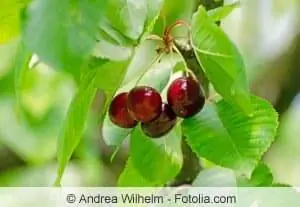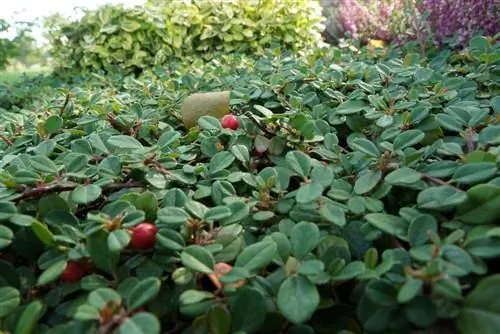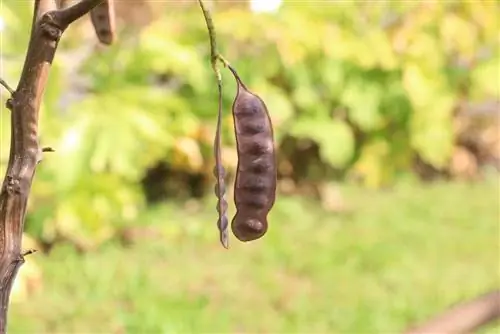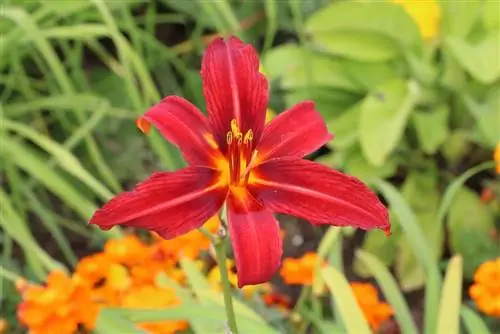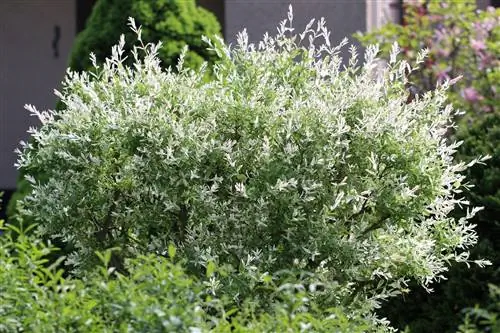- Author admin [email protected].
- Public 2023-12-17 03:39.
- Last modified 2025-06-01 06:48.
Trees and bushes are very popular in hobby gardens as privacy screens and shade providers. But they do different amounts of work. They also have different flowering times and growth heights. Some shrubs and trees bear fragrant flowers, others do not have flowers. There are evergreen and deciduous trees and shrubs. When selecting plants, it is always important for the hobby gardener to know what the plants are like. That's why we've put together a list of the most common shrubs and trees in the garden.
Trees in the garden
Trees are woody, long-lived plants. They have a trunk that tapers towards the top, from which stronger branches and thinner twigs covered with leaves emerge at the top. Trees form so-called crowns.
Classification according to height
Trees in the garden are divided according to their growth height into small trees (third-order trees, growth height 2 to 10 m), medium-sized trees (second-order trees, growth height 10 to 20 m) and large trees (first-order trees, growth height over 20 m).) assigned. Some of the small trees also grow as so-called large shrubs. Large trees are rarely planted in hobby gardens because of their very large growth and when they are, they can be found as so-called house trees in individual positions near the house or in large garden meadows.
Classification according to leaf drop
The trees can also be classified according to deciduous trees, i.e. deciduous trees that shed leaves, evergreen deciduous trees and conifers:
Summer green trees
These trees lose their leaves in autumn, unlike the evergreen deciduous trees that retain their leaves even in winter.
Various types of deciduous small trees:
- Maple (Acer) for example field maple (Acer campestre), fire maple (Acer ginnala) and Japanese maple (Acer palmatum)
- Crabapple (Malus) in different varieties with red flowers and small fruits
- Spindle bush (Euonymus europaeus) with green-white flowers and red fruits - poisonous
- Olive willow (Elaeagnus angustifolia)
- Loose tree (Clerodendrum trichotomum)
- Tulip magnolia (Magnolia x soulangeana)
- Red hawthorn (Crataegus laevigata 'Paul's Scarlet')
- Catkin willow (Salix caprea 'Mas')
- Elderberry (Sambucus) - also growing as a shrub
- Medlar (Mespilus germanica) - fruit tree
- Crabapple (Malus sylvestris) - fruit tree
- Plum (Prunus domestica) - fruit tree
- Sour cherry (Prunus cerasus) - fruit tree
- Common hazel (Corylus avellana) - also found as a nut bush
- Ornamental cherry (Prunus serrulata) in different varieties with red leaves and red stone fruits
- Various types of deciduous medium-sized trees
- Whiteberry (Sorbus aria)
- Serviceberry (Sorbus torminalis)
- Purple ash (Fraxinus angustifolia 'Raywood')
- Norway maple (Acer platanoides 'Columnare')
- Tree hazel (Corylus colurna) with conical crown and fruits in clusters - walnut
- Walnut (Juglans regia) with a sprawling crown - walnut
- Sorbus domestica - fruit tree
- Late-flowering bird cherry (Prunus serotina) - fruit tree
- Sweet cherry (Prunus avium) - fruit tree
Various types of deciduous large trees
- Birch (Betula) in different varieties
- Beech (Fagus sylvatica) in different varieties
- Maple (Acer) in different varieties
- Hornbeam (Carpinus betulus) is also often used as a hedge shrub
- Oak (Quercus) in different varieties
- Ash (Fraxinus) in different varieties
- Gingko (Gingko biloba)
- Elm (Ulmus) in different varieties
- Linde (Tilia) as summer and winter linden tree
- Poplar (Populus) in different varieties
- Robinia (Robinia pseudoacacia)
- Horse chestnut (Aesculus) in different varieties
- Chestnut (Castanea sativa) - Walnut
Evergreen deciduous trees
Small, evergreen deciduous trees
- Laurel cherry (Prunus laurocerasus)
- Evergreen boxwood (Buxus sempervirens) can be used as a hedge shrub - poisonous
Medium-sized, evergreen deciduous trees
Holly (Ilex aquifolium) with red fruits
Conifers
Conifers are also often referred to as conifers. They have tough and hard, narrow leaves that appear needle-shaped on most conifers. The leaves are very resilient and remain on the tree even in winter.
Small conifers
- Dwarf columnar juniper (Juniperus communis 'Compressa')
- Korea fir (Abies koreana)
- Cypress (Chamaecyparis) in different species
- Sugarloaf spruce (Picea glauca 'Conica')
Medium-sized conifers
- Common juniper (Juniperus communis)
- Spruce (Picea)
- European yew (Taxus baccata) - poisonous
- Pine (Pinus) in different varieties
- Occidental tree of life (Thuja occidentalis) - poisonous
Large conifers
- Sequoia trees (Sequoioideae)
- Larch (Larix decidua)
- White fir (Abies alba)
- Douglas fir (Pseudotsuga menziesii)
- Scottish fir (Picea abies)
- Blue spruce (Picea pungens 'Glauca')
- Black pine (Pinus nigra)
Shrubs in the garden
Shrubs do not form a trunk. Their branches can grow directly from the earth or branch close to the ground.
Shrubs with flowers (flowering bushes)
White flowers
- Firethorn (Pyracantha)
- Black elderberry (Sambucus nigra) - flowering in June and July
- Common serviceberry (Amelanchier ovalis) - flowering in April and May before the leaves emerge, purple to blue-black fruits
- Lilac (Syringa - Vulgaris - Hybride)
- Red dogwood (Cornus sanguinea) - flowering period from May to June, umbrella panicles, for bees
- Red honeysuckle (Lonicera xylosteum) - flowering period from May to June, spherical, dark red fruits - poisonous

Yellow flowers
- Forsythia (Forsythia), for example Forsythia intermedia 'Goldzauber' or Spectabilis
- Five finger bush variety Potentilla fruticosa 'Kobold'
- Gold shower (Laburnum anagyroides)
- Thunberg's barberry (Berberis thunbergii 'Atropurpurea')
- Blisterbush (Colutea arborescens) - Lepidoptera
- Coral berry (Symphoricarpos orbiculatus) - yellow-white flowers in June and July, ruby-red, ribbed fruits
Orange flowers
Five finger bush variety Potentilla fruticosa 'Red Ace'
Pink flowers
- Lilac (Syringa - Vulgaris - Hybride)
- Kolkwitzia (Kolkwitzia amabilis) - pinkish-white, bell-shaped flowers in May and June
Red flowers
- Lilac (Syringa - Vulgaris - Hybride)
- Cinnamon raspberry (Rhubus odoratus L.) - purple flowers
- Blood currant (Ribes sanguineum 'Atrorubens') - blood-red flowers in April and May
Purple flowers
Lilac (Syringa - Vulgaris - Hybride)
Blue flowers
- Lilac (Syringa - Vulgaris - Hybrid) - sky blue flowers
- Small periwinkle (Vinca minor) - blooms from May to September
- Beardflower (Caryopteris x clandonensis 'Heavenly Blue') - dark blue flowers in August and September
Evergreen Shrubs
- Low berry (Gaultheria procumbens) - also called red carpet berry
- Large-leaved periwinkle (Vinca major)
- Snow heather (Erica carnea)
- Cotoneaster
- Evergreen peat myrtle (Pernettya mucronata)
- Shadow bell (Pieris floribunda)
- Laurel rose (Kalmia angustifolia)
- Grape heather (Leucothoe Scarletta)
- Boxwood (Buxus sempervirens)
Tip:
Evergreen shrubs and medium-sized conifers can also be planted in pots and boxes and placed around the terrace to create a beautiful privacy screen. The advantage of these shrubs in the pot is that they can be moved at any time.
Fruit bushes (fruit and nut bushes)
Fruit bushes in the hobby garden are not only interesting for your own harvest, but some species are also an important source of food for many local birds, small mammals and insects.
Typical fruit and nut bushes
- Jostaberry (Ribes × nidigrolaria)
- Raspberry (Rubus idaeus)
- Blueberry (Vaccinium myrtillus)
- Red currant (Ribes rubrum)
- Blackcurrant (Ribes nigrum)
- Cranberry (Vaccinium vitis-idaea)
- Gooseberry (Ribes uva-crispa)
- Dewberry (Rubus caesius) - usually growing wild in the garden
- Lambert Shasel (Corylus maxima)
- Blood Hazel (Corylus maxima 'Purpurea')
- Hazel (Corylus avellana)
Tip:
For fruit bushes, it is a good idea to set up a so-called sweet hedge in the garden, provided the bushes love the same location conditions.
Classification by root type
A rough classification based on the growth habit of the roots of trees and shrubs is often useful in order to select the appropriate location.
- Flat-rooted plants: Shallow-rooted plants are trees and shrubs with a plate-shaped, shallow root system beneath the soil surface. They do not penetrate deep layers of soil. When planted, these plants require a support stake. In addition, their roots can push through the lawn. These include, for example, spruce, birch, fir, willow, hornbeam, barberry, currant, magnolia, gooseberry and serviceberry.
- Taproot: These trees are characterized by the development of their strong main root, which penetrates into deep layers of soil. In addition, this main root has few lateral roots. Typical representatives of these trees are cedar, larch, pine, oak and yew.
Conclusion
Classifying tree and shrub species for the garden is very complex. In general, almost all evergreen trees and shrubs can be used as hedge plants and privacy and wind protection elements if they are pruned accordingly. However, the large trees tend to be planted alone. We hope that our overview of shrubs and trees will help you choose plants for your garden.

